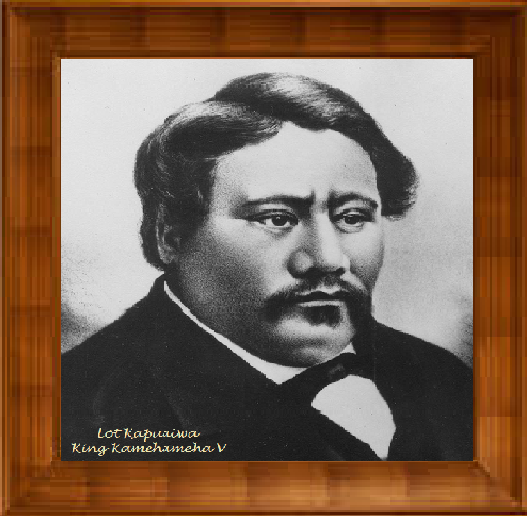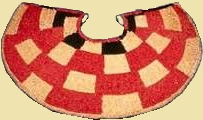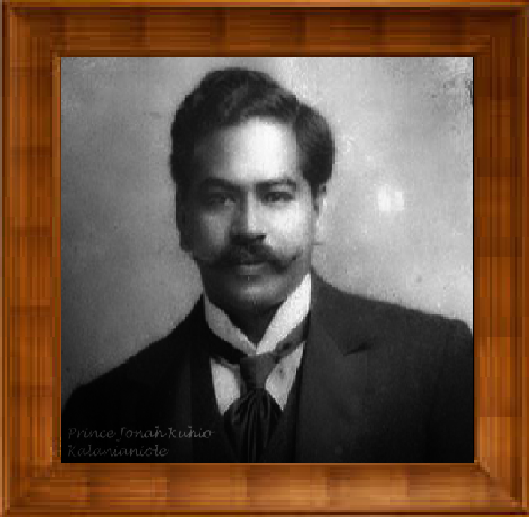
|
 Lot Kapua'iwa King Kamehameha V  |

|
|
The Royal Order of Kamehameha I was established on April 11, 1865 by his Majesty King Kamehameha V (Lot Kapuaiwa) to honor the legacy of his grandfather, the unifier of these islands, Kamehameha the Great. Lot Kapuaiwa,
His Majesty King Kamehameha V founded the Royal Order of Kamehameha I to defend the sovereignty of the Kingdom of Hawaii. After the overthrow of Her Majesty Queen Lili’iuokalani, the Provisional government declared the
Royal Order of Kamehameha I a threat. The Order went underground until 1903 when His Royal Highness Prince Jonah Kuhio Kalanianaole led a torchlight ceremony around the statue of Kamehameha I and declared in public the
restoration of the Royal Order of Kamehameha I, announced the reorganization of the Hawaiian Royal Societies, and created the Hawaiian Civic Clubs.
Genealogy
Parliament
“He was a master in the beginning, & at the middle, & to the end. The Parliament was the “figure-head,” & it never was much else in his time. … He hated Parliaments, as being a rasping & useless incumbrance
upon a king, but he allowed them to exist because as an obstruction they were more ornamental than rival.” (Twain) “He surrounded himself with an obsequious royal Cabinet of American & other foreigners, & he
dictated his measures to them &, through them, to his Parliament; & the latter institution opposed them respectfully, not to say apologetically, & passed them.” (Twain) Kamehameha V modeled his leadership after
that of his grandfather, Kamehameha I, believing that it was the right and duty of the chiefs to lead the common people. He refused to support the Constitution of 1852. By supporting the controversial
Constitution of 1864, he expected to regain some of the powers lost by previous kings. (ksbe) “He was not a fool. He was a wise sovereign; he had seen something of the world; he was educated & accomplished,
& he tried hard to do well for his people, & succeeded.
Reign
There was no rival nonsense about him; he dressed plainly, poked about Honolulu, night or day, on his old horse, unattended; he was popular, greatly respected, & even beloved.” (Twain) In 1865, a bill to repeal
the law making it a penal offense to sell or give intoxicating liquor to native Hawaiians was brought before the legislature. Strongly supported by some, Kamehameha surprised the supporters saying,
“I will never sign the death warrant of my people.” The measure was defeated in the second reading. (Alexander) Kamehameha V founded the Royal Order of Kamehameha on April 11, 1865 in commemoration of
his grandfather, Kamehameha I. The stated purpose of the order was “to cultivate and develop, among our subjects, the feelings of honour and loyalty to our dynasty and its institutions and … to confer honorary
distinctions upon such of our subjects and foreigners as have rendered, or may hereafter render to our dynasty and people, important services.” (Royal Order)
Hansens Desease
Hansen’s Disease was rapidly spreading on Oʻahu. In response, the legislature passed “An Act to Prevent the Spread of Leprosy” in 1865, which King Kamehameha V approved. This law provided for setting
apart land for an establishment for the isolation and seclusion of leprous persons who were thought capable of spreading the disease. The first shipment of lepers landed at Kalaupapa January 6, 1866, the
beginning of segregation and banishment of lepers to the leper settlement. By 1866, the need for a new courthouse government building in the Hawaiian Kingdom was apparent. The legislature appropriated
funds towards a new palace and a new government building. Delays ensued. Plans for a new palace were postponed, but the new courthouse moved forward. On February 19, 1872, Kamehameha V laid the cornerstone
for Aliʻiolani Hale (now home to the Hawaiʻi Supreme Court.) King Kamehameha V encouraged the revival of native practices. On Maui, a group of eight Hawaiians founded the ʻAhahui Laʻau Lapaʻau.
In 1868, the Legislature established a Hawaiian Board of Health to license kahuna laʻau lapaʻau. Kahuna practices including lomilomi massage and laʻau kahea healing remained legal for the next twenty
years. (princeton-edu)
Accomplishments
Later, his summer home in Moanalua Gardens became the home of the annual Prince Lot Hula Festival, the largest non-competitive hula event in Hawai‘i. It honors Lot Kapuāiwa who helped to revive hula by staging
pāʻina (parties) at his summer home. (Save the date, July 19, 2014, for the 37th annual event at Moanalua Gardens.) The Kamehameha V Post Office (built in 1871, one of the oldest remaining public
buildings in Hawaiʻi, and so named because it was built at the direction of Kamehameha V) was the first post office building in Hawaiʻi. For many years, it also housed the publishing and printing
office of the Hawaiian Gazette and other small companies and organizations needing office space. (NPS) December 11, Lot Kapuāiwa celebrated the first Kamehameha Day in 1871 as a day to honor his grandfather;
the first celebration fell on Lot’s birthday. Because the weather was better in the summer, the decision was made to move the Kamehameha I celebration six months from the King Kamehameha V’s birthday
(so it was moved to June 11 – the date has no direct significance to Kamehameha I.) The 1896 legislature declared it a national holiday. (Kamehameha Day continues to be celebrated on June 11.) He had a law passed by
the Legislative Assembly in 1872 that funded and authorized the acquisition of the hotel on the corner of Hotel Street and Richards Street by the Hawaiian government, which he named the Royal Hawaiian Hotel.
(The “Pink Palace” in Waikīkī was a different/subsequent Royal Hawaiian, built in 1927.)
Bernice Pauahi was betrothed to Lot Kapuāiwa; but when Mr Charles R Bishop pressed his suit, Pauahi “smiled on him, and they were married. It was a happy marriage.” (Liliʻuokalani) Lot Kapuāiwa never married.
“On the 10th (of December, 1872,) (Liliʻuokalani and her husband) were summoned to the palace to attend the dying monarch; one by one other chiefs of the Hawaiian people, with a few of their trusted retainers, also arrived to be present at the final scene; we spent that night watching in silence near the king’s bedside. The disease was pronounced by the medical men to be dropsy on the chest (hydrothorax, accumulation of fluid in the chest.”) (Liliʻuokalani)
“Although nearing the end, the mind of the king was still clear; and his thoughts, like our own, were evidently on the selection of a future ruler for the island kingdom, for, turning to Mrs. Bishop, he asked her to assume the reins of government and become queen at his death.” She declined. “… he relapsed into unconsciousness, and passed away without having named his successor to the throne.” (Liliʻuokalani) (Lunalilo was shortly after elected King of Hawaiʻi.)
December 11, 1872, Lot Kapuāiwa died; it was his 42 birthday.
|
 |
|
 |
|
Today, the organization continues to guard, maintain, and preserve the rituals and the memory of the ruling Chiefs of Hawaii. The purpose of the Royal Order of Kamehameha I as it is known today is to unite in fraternal
and benevolent work, men of Hawaiian descent, of good moral character, of sound bodily health; to cultivate the cardinal principles of friendship, charity and benevolence; to aid widows and orphans; to improve the social
and moral conditions of its members; to provide scholarship assistance; to preserve and perpetuate the ancient culture, customs, and traditions of Hawai’i, uplift the Hawaiian people; infuse the spirit of patriotism,
loyalty, helpfulness and kindness among its members; advance the interest of its members in every rightful cause, and to encourage and develop leadership.
|

